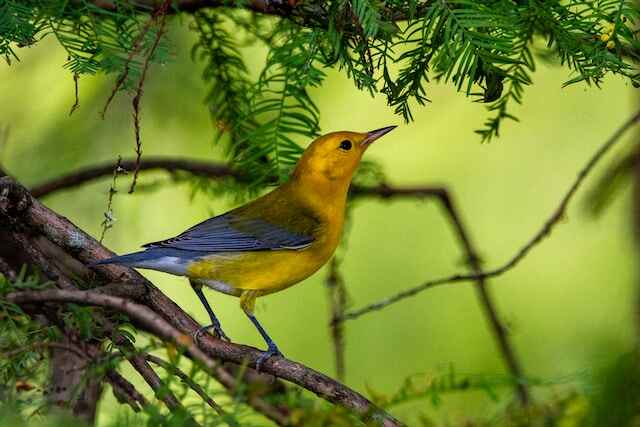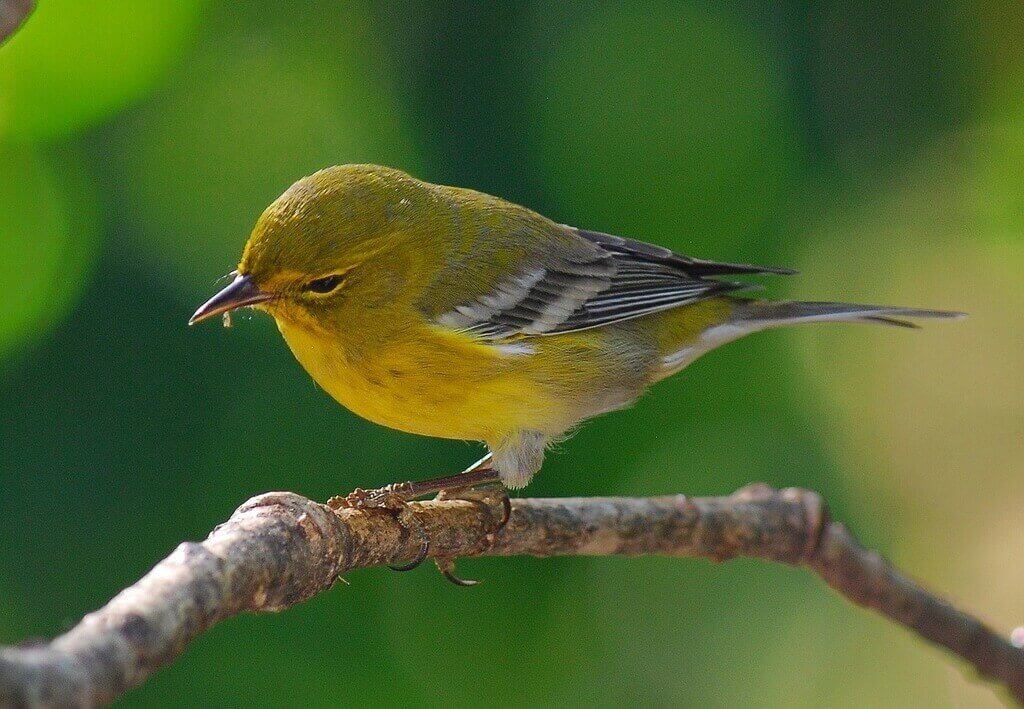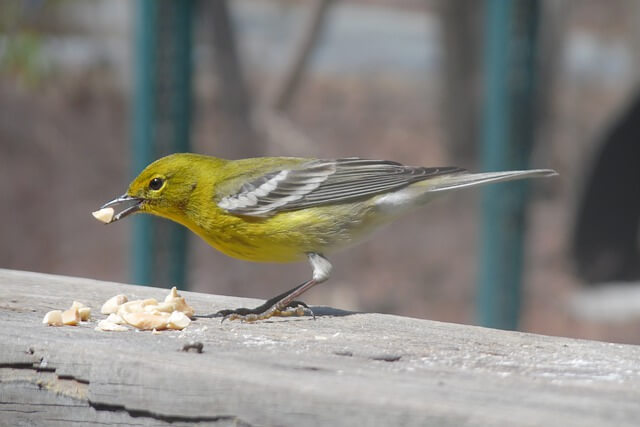Warblers are a favorite among backyard birders. These birds typically come to your yard for the food, water and shelter you provide. In this article, I will give you expert tips on how to attract warblers to your yard so that they can become regular visitors.
Table of Contents
What do Warblers Look Like?
- Colorful Plumage: Warblers are renowned for their stunning array of colors, making them a delight to observe. From vibrant yellows and oranges to striking blues and greens, their plumage adds a burst of beauty to any natural setting.
- Varied Markings: The markings on warblers’ feathers are as diverse as the species themselves. Some warblers boast intricate patterns of stripes, spots, or bars, while others exhibit bold patches of color on their wings or tails. These markings serve as key identifiers and can vary significantly between different warbler species.
- Size and Shape: Warblers come in various sizes, ranging from small to medium-sized birds. Their slender bodies, pointed beaks, and agile movements are adaptations that enable them to navigate through foliage as they forage for insects and larvae.
- Distinctive Head Patterns: One notable feature of warblers is their unique head patterns. Many species showcase distinct eyelines, eye rings, crowns, or stripes that contribute to their individual charm. These patterns often play a crucial role in differentiating between various warbler species.
- Wing Bars and Tail Patterns: The wings and tails of warblers often display specific markings that aid in identification. Look for wing bars, which can be thin or bold, and tail patterns such as spots or bands that add a touch of elegance to their aerial displays.
- Sexual Dimorphism: In some warbler species, males and females exhibit differences in coloration and patterns, a phenomenon known as sexual dimorphism. This variation can be subtle or striking, with males often showcasing brighter colors to attract mates, while females may display more muted tones for camouflage during nesting.

Common Types of Warblers
| Warbler Type | Scientific Name | Distribution | Habitat | Diet |
|---|---|---|---|---|
| American Redstart | Setophaga ruticilla | North and Central America | Forests, woodlands, parks | Insects, berries, nectar |
| Yellow Warbler | Setophaga petechia | North and Central America | Wetlands, shrubby areas | Insects, fruits |
| Common Chiffchaff | Phylloscopus collybita | Europe, Asia, Africa | Woodlands, gardens, parks | Insects, spiders |
| Blackcap | Sylvia atricapilla | Europe, Asia, Africa | Woodlands, gardens, parks | Insects, fruits, berries |
| Blackburnian Warbler | Setophaga fusca | North and Central America | Coniferous forests | Insects, spiders, nectar |
Note: This table includes just a few examples of the many warbler species found worldwide.
Distribution Range
Warblers are a diverse group of birds found across a vast range, making them one of the most common native species in North America, the Caribbean, South and Central America.
They also extend their presence into northern South America. In fact, North America alone boasts an impressive variety of 50 warbler species.
Warblers can be found across multiple regions, including Central and South America, spanning the entire Western Hemisphere from Central America to Argentina.
Their distribution is not limited to the Americas alone, as they also inhabit Eastern Australia and various islands in the Western Pacific and Indian Oceans.
Their adaptability and widespread presence make them a fascinating and widely studied group of birds.
Habitat
Warblers are adaptable birds that can be found in a diverse range of habitats. While they can inhabit various ecosystems, they show a preference for open woodlands with dense undergrowth.
Some of the habitats where warblers are commonly found include oak-hickory forests, pine flatwoods, coastal hammocks, woodland edges, forest clearings, parks, gardens, and scrubby barrens.
These environments provide the necessary conditions for warblers to thrive, offering a mix of vegetation, shelter, and food sources.
The ability of warblers to occupy different habitats showcases their resilience and ability to adapt to different ecological niches.
How to Attract Warblers to your Yard
Setting Up a Bird Feeder
If you’re eager to attract warblers during the spring and summer seasons, there are several food options that can entice these beautiful birds.
Warblers are known to be attracted to nectar, oranges, jelly, seeds, peanut butter, and suet cakes. To successfully attract warblers, it is important to ensure that these food sources are readily available.
Two effective methods for attracting warblers are as follows:
- Mealworms in platform feeders: Placing mealworms in platform feeders can be an enticing option for warblers. These small, protein-rich treats are a favorite among many bird species, including warblers. By offering mealworms in an accessible and open feeding platform, you increase the likelihood of attracting these delightful birds.
- Bird’s Choice 2-Cake Suet Feeder with peanut butter suet cakes: Another effective approach is to use the Bird’s Choice 2-Cake Suet Feeder in combination with peanut butter suet cakes. Warblers are known to be attracted to suet, and peanut butter suet cakes provide a high-energy and appealing food source. The Bird’s Choice feeder is designed to hold multiple suet cakes, providing ample sustenance for warblers and other birds.
You can find a variety of platform feeders, mealworms, and suet feeders with peanut butter suet cakes available for purchase on Amazon. These products offer convenience and accessibility in your efforts to attract warblers to your backyard.
By implementing these methods and providing a diverse range of food sources, you increase the chances of attracting warblers and enjoying their presence in your outdoor space.
Creating an Inviting Birdbath
If you’re looking to attract warblers to your backyard, a birdbath can be a fantastic addition. Warblers are particularly drawn to the sound of dripping water, making a birdbath an enticing feature for these beautiful birds.
A birdbath serves as more than just a water source; it provides a suitable habitat for warblers in your area. Not only can they quench their thirst, but they can also enjoy bathing and keeping their feathers clean.
To maximize the attractiveness of your birdbath, consider the Alpine Birdbath, a popular choice among bird enthusiasts. You can check the current price on Amazon.
In addition to serving as a water source, a birdbath can also be utilized as a platform feeder.
This versatility allows you to attract warblers by offering them black-oil sunflower seeds, a favored food source.
By incorporating a birdbath into your backyard, you create an inviting oasis for warblers, providing them with water, bathing opportunities, and potential feeding spots.
Enjoy the beauty of warblers while contributing to their well-being.
Providing Adequate Shelter
To ensure the availability of suitable shelter for warblers in your garden or backyard, you can take the following steps:
- Create a Variety of Vegetation: Plant a diverse selection of trees, bushes, and vines in your garden to offer different levels of cover and nesting opportunities for warblers. Native species are particularly beneficial as they provide familiar habitats and food sources for these birds.
- Place Feeders Strategically: Position bird feeders at an appropriate height to minimize contamination by droppings and discourage squirrels from accessing them. This prevents squirrels from stealing the birdseed and ensures that the warblers have access to the food without interference.
- Provide Nesting Materials: Offer a platform near the feeders containing suitable nesting materials for warblers. Cedar shavings, chopped corn cobs, or pine straw can be used as nesting materials, providing the birds with readily available resources to build their nests.
- Consider Sheltered Locations: Place nest boxes or artificial nesting structures in sheltered areas near windowpanes with early morning sun exposure. This provides additional warmth during cold winter months when it may be challenging for warblers to find sufficient food. The warmth from the sun can be beneficial for the birds and increase their chances of survival.
By implementing these measures, you can create a welcoming environment for warblers, ensuring they have adequate shelter, nesting materials, and access to food sources.
Establishing Nesting Sites
To attract warblers to your yard, it’s important to provide suitable nesting sites. Warblers have a preference for areas with trees and shrubs, as these provide the ideal conditions for nesting.
These locations not only offer a secure place for them to build their nests, but also allow them to have a vantage point to observe other birds and spot potential predators.
Warblers choose various nesting spots depending on the species. Some may nest in hollowed-out trees, while others prefer tree stumps, branches, twigs, bushes, or even bird houses.
In some cases, you might even find them nesting near roads and walkways. They are adaptable and can also use alternative structures like barns, bird houses, or buildings.
Their nests are typically constructed using materials such as moss, bark strips, grass, leaves, and plant down. Providing these natural materials in your yard can further encourage warblers to build their nests.
During winter, offering a warm place for warblers to roost can greatly increase their presence.
Consider using high-quality birdhouses, like this durable birdhouse from Woodsmith, which provides a cozy shelter for these birds.
By creating suitable nesting sites and providing comfortable roosting options, you can attract warblers to your yard and enjoy their delightful presence throughout the year.
Planting Trees and Shrubs
To attract warblers to your yard, consider planting a variety of trees and shrubs that they find appealing. It’s best to choose locations where you can easily observe them on a daily basis.
Here are some tree and shrub species that are known to attract warblers:
| Species | Species | Species |
|---|---|---|
| Oak | Willow | Eastern White Pine |
| Maple | Cypress | Pine |
| Beech | Sycamore | Eastern Hemlock Spruce |
| Bayberry | Elderberry | Serviceberry |
| Honeysuckle | Sumac | Blackberry |
| Dogwood | Wild Grape | Juniper |
| Mulberry | Bayberry |
By incorporating these specific trees and shrubs into your yard, you can create an inviting habitat that provides food, shelter, and nesting sites for warblers.
Cultivating Attractive Flowers and Vines
When it comes to attracting warblers, planting the right flowers and vines is crucial. These types of plants are highly enticing to these birds, so it’s important to choose ones that will catch their attention and provide them with valuable resources.
Here are some recommended flowers and vines that are known to attract warblers:
- Virginia Creeper: This native vine not only adds beauty to your garden, but also offers dense foliage and small berries that warblers find appealing.
- Pokeweed: Warblers are known to be attracted to the clusters of dark purple berries that pokeweed produces. However, it’s important to note that this plant can be toxic to humans and pets, so exercise caution when planting it.
- Fuchsia ‘Gartenmeister Bonstedt’: The vibrant red flowers of this fuchsia variety are a magnet for warblers. Their nectar-rich blooms provide a valuable food source for these birds.
- Hibiscus: The large, showy flowers of hibiscus are not only visually appealing, but also attract warblers with their nectar. Consider planting both native and hybrid varieties to provide a range of colors and blooming periods.
- Azaleas: These colorful shrubs offer nectar-filled flowers that warblers find irresistible. Choose varieties that are native to your region to ensure they are well-suited for local warbler species.
- Honeysuckle: The sweet scent and nectar of honeysuckle flowers make them highly attractive to warblers. Look for native species, such as trumpet honeysuckle (Lonicera sempervirens), to support local wildlife.
- Spirea: This flowering shrub produces clusters of small, delicate flowers that warblers are known to visit for nectar. It’s a great choice for adding diversity to your garden and attracting these birds.
When planting these flowers and vines, consider their bloom times to ensure a continuous food source for warblers throughout the season.
Additionally, providing a mix of flowering plants that bloom at different heights and offer a variety of flower shapes and colors will further enhance their attraction to warblers.
Remember to provide a suitable habitat with dense vegetation and a water source, such as a birdbath, to create an inviting environment for warblers.
By incorporating these recommended plants, you’ll increase the likelihood of attracting these beautiful birds to your garden and provide them with the resources they need to thrive.
Additional Tips for Attracting Warblers
- Create an environment with dense shrubs and trees for protection from predators.
- Purchase a bird house that is large enough to provide protection from both wind and rain.
- Plant native trees that produce fruits or berries during the summer months like hawthorn or cedar elm trees.
- Choose plants that have small berries or fruit. Warblers feed on these types of foods and need them in their diet to survive the winter months.
- Warblers are small birds that measure 10 -18 cm long and weigh between 8 -12 grams, depending on the species. These birds can move fast, so it can be difficult to get a good look and, I think it would be wise to get a pair of binoculars like the Celestron – Nature DX 10×42 Binoculars, so you can get a better view.
- If you have a large tree and a birdbath or natural pond you can place a perch near the edge of the tree. This can be a great way to attract Warbler into your yard or garden.
- If you have a water fountain, nest boxes are some things that you will need to have in order to keep the warblers in the garden.
- Offer nesting materials like cattails, grasses, and dried leaves for warblers looking for a safe place to nest during breeding season.
- Create a home-base in the middle of your yard – this should be something interesting like a hollow log or tree stump, so they can feel safe and secure.
- Clean and fill the feeder at least once per week.
- Keep a shallow dish of water nearby for birds to drink from.
Conclusion
In conclusion, attracting warblers to your yard is a rewarding endeavor that can bring joy and a deeper connection with nature.
By following the strategies outlined in this guide, you can create an inviting habitat that entices these enchanting birds to visit and even nest in your own backyard.
Remember, providing a diverse array of native plants that offer food sources, such as berries and nectar, is essential for attracting warblers.
Creating layers of vegetation, including trees, shrubs, and low-growing plants, mimics their natural habitats and provides shelter and foraging opportunities.
Water features like bird baths or shallow pools can also be a significant attraction for warblers, as they require fresh water for drinking and bathing.
Moreover, reducing the use of pesticides and embracing organic gardening practices helps maintain a healthy environment, ensuring a sustainable food supply for warblers and other bird species.
Patience is key when attracting warblers, as they may take time to discover and trust the habitat you’ve created.
However, the rewards are well worth the effort. The sight of these vibrant birds flitting through the foliage and filling your yard with their melodious songs is a true testament to the success of your efforts.
Lastly, continue to learn about the different warbler species that frequent your region, as this knowledge will enable you to adapt your yard to meet their specific needs.
Local birdwatching groups, field guides, and online resources are valuable tools for expanding your understanding and appreciation of these captivating birds.
So, go ahead and embark on your journey to attract warblers to your yard.
With dedication, a little creativity, and a deep appreciation for nature, you can transform your outdoor space into a haven that warblers will call home.
Enjoy the beauty and wonder that warblers bring, and let their presence fill your yard with an undeniable sense of harmony and vitality.
Frequently Asked Questions
Do Warblers eat mealworms?
The answer is yes, Warblers love mealworms. Warblers are often seen foraging in the ground and eating any food that they can find, including insects such as worms or grubs.
What insects do Warblers eat?
Warblers are one type of bird that feed on insects to survive. Their favorite insects to eat are caterpillars, crickets, beetles, moths, ants, spiders, and grasshoppers
Do Warblers eat grapes?
Yes, warblers eat grapes. They are often found near grape vines, and in some cases, they will even go as far as to eat the grapes right off of the vine.
Do Warblers eat oranges?
Yes, warblers can eat oranges. Warblers are often seen eating fruit in their natural habitat and this is not surprising considering that they have been observed eating figs, berries, bananas, and of course grapes.
How far away should a bird bath be from a bird feeder?
A bird bath should be placed within 10 feet away from the feeder and near some trees, so they can escape predators if they need to. Make sure that it’s also near a place where there are no windows or doors on the ground level of your house, because these areas will make them vulnerable to attack by predators like raccoons and coyotes.






